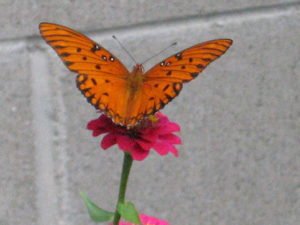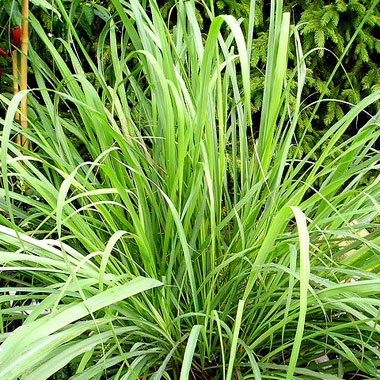by Susan Dean | Feb 5, 2018 | Herbs, Kitchen Recipes
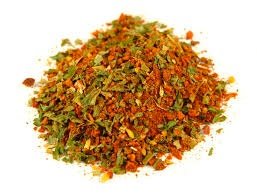
Taco Seasoning
1/2 cup chili powder
1/4 cup onion powder
1/8 cup ground cumin
1 tablespoon garlic powder
1 tablespoon paprika
1 tablespoon sea salt
Directions:
Mix all ingredients in a jar. Shake the jar to mix the ingredients well before each use.
Store in a dry, cool place.
Dry Onion Soup Mix
2/3 cup dried, minced onion
3 teaspoons parsley flakes
2 teaspoons onion powder
2 teaspoons turmeric
1 teaspoon celery salt
1 teaspoon sea salt
1 teaspoon sugar
1/2 teaspoon ground pepper
Mix all ingredients in a jar. Shake to mix ingredients well before each use. Store in a dry, cool place.
Ranch Mix
5 tablespoons dried minced onions
7 teaspoons parsley flakes
4 teaspoons salt
1 teaspoon garlic powder
Mix ingredients in a jar, then shake the jar to mix the ingredients well before each use. Store in a dry, cool place.
Spice Blends
Nightshade free? Do not use recipes with paprika, chili powder, chipotle powder or red pepper flakes.
Combine spices in a bowl and store in a small container.
Smoky Spice Blend
1 Tbl chipotle powder
1 Tbl smoked paprika
1 Tbl onion powder
½ Tbl cinnamon
1 Tbl salt
½ Tbl black pepper
Chorizo Spice Blend
2 Tbl chipotle powder
1 Tbl smoked paprika
1 bl onion powder
1 Tbl garlic powder
½ Tbl sea salt
1 tsp. black pepper
Cooling Spice Blend
1 Tbl tumeric
1 Tbl cinnamon
1 Tbl cumin
1 Tbl oregano
1 tsp black pepper
1 Tbl onion powder
1 Tbl garlic powder
Indian Spice Blend
2 Tbl onion powder
2 tsp. garam masala
2 tsp coriander
1 tsp sea salt
1 tsp black pepper
½ tsp. cinnamon
½ tsp red pepper flakes
Italian Sausage Spice Blend
(Use 2 Tbl per pound of meat to make sausage.)
1 tsp sea salt
1 Tbl fennel seeds ground
1 Tbs rubbed sage
1 Tbl garlic powder
1 Tbl onion powder
¼ tsp white pepper
2 tsp dried parsley
Curry Spice Blend
1 Tbl curry powder
1 Tbl onion powder
1 Tbl paprika
½ Tbl cinnamon
1 Tbl sea salt
Savory Spice Blend
2 Tbl rosemary-sage salt
1 Tbl garlic powder
1 Tbl onion powder
½ Tbl paprika
1 tsp black pepper
Greek Spice Blend
2 Tbl lemon salt
2 Tbl dried oregano
1 Tbl garlic powder
2 tsp black pepper
by Susan Dean | Feb 3, 2018 | Herbs, Kitchen Recipes
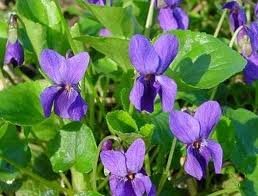
When you fix that healthy salad make add fresh herbs and colorful flowers!
Edible Flowers: Violet, Nasturtium, Pansy, Calendula, French Marigold, Bee Balm, Squash blossoms,
Day lilies, Borage, Thyme, Oregano, Honey suckle, Rose, Lavender, Jasmine, Sage, chamomile, Primrose, Orange,
Apple, Pinks, Carnation, Mint, Thyme, clover, chervil, chrysanthemums, dandelion, daylillies, roses, hyacinths,
gladiolas, hollyhocks,impatiens, lilac, Chive, Red runner bean. The blossoms of chive, garlic, and pea are also edible.
Sprinkle flowers on salads or use as garnishes. Steep flower petals in vinegar 3 weeks for a floral-infused
vinegar for salad dressings. Stir chopped petals into softened butter for a colorful spread. Large squash
blossoms can be dipped in a batter and fried, or stuffed and baked.
*Only eat flowers or anything for that matter that you know are safe and free of herbicides and pesticides.
Most herbs in the garden have flowers that are beautiful, colorful and edible with a mild taste similar to that of the leaves.
To keep flowers fresh, place them on moist paper towels and refrigerate in an airtight container. Some will last up to 10 days this way. Ice water can revitalize limp flowers. The following is a list of edible flowers:
1. Allium blossoms (leeks, chives, garlic, garlic chives) are edible and flavorful! Every part of these plants is edible.
2. Angelica flowers range from pale lavender-blue to deep rose and have a licorice-like flavor.
3. Anise hyssop flowers and leaves have a subtle anise or licorice flavor.
4. Arugula blossoms are small with dark centers and a peppery flavor like the leaves. They range in color from white to yellow with dark purple streaks.
5. Bachelor’s button is grassy in flavor, the petals are edible. Avoid the bitter calyx.
6. Basil blossoms come in a variety of colors, from white to pink to lavender; flavor is similar to the leaves, but milder.
7. Bee balm red flowers have a minty flavor.
8. Borage blossoms are a lovely blue and taste like cucumber!
9. Calendula / marigold golden blossoms are peppery, tangy, and spicy.
10. Carnations / dianthus petals are sweet, once trimmed away from the base. Blossoms taste like their sweet, perfumed aroma.
11. Chamomile’s small and daisylike flowers have a sweet flavor and are often used in tea. Ragweed sufferers may be allergic to chamomile.
12. Chervil has delicate blossoms and flavor, which is anise-tinged.
13. Chicory has a mildly bitter earthiness evident in the petals and buds, which can be pickled.
14. Chrysanthemum is a little bitter, mums come in a rainbow of colors and a flavor range from peppery to pungent. Use only petals.
15. Cilantro – people either love the blossoms or hate them. The flowers share the grassy flavor of the herb. Use fresh as they lose their charm when heated.
16. Citrus (orange, lemon, lime, grapefruit, kumquat) blossoms are sweet and highly scented. Use frugally or they will over-perfume a dish.
17. Clover flowers are sweet with a hint of licorice.
18. Dandelion add a bright yellow to dishes
19. Dill – The yellow dill flowers taste much like the herb’s leaves.
20. English daisy – Petals are somewhat bitter — but they look great!
21. Fennel – Yellow fennel flowers have a subtle licorice flavor like the herb itself.
22. Fuchsia – Tangy fuchsia flowers make a beautiful garnish.
23. Gladiolus – Although gladioli are bland, they can be stuffed, or their petals removed for an interesting salad garnish.
24. Hibiscus, famously used in hibiscus tea, the vibrant cranberry flavor is tart and can be used sparingly.
25. Hollyhock – Bland and vegetal in flavor, hollyhock blossoms make a showy, edible garnish.
26. Impatiens flowers don’t have much flavor – best as a garnish or for candying.
27. Jasmine’s super-fragrant blooms are used in tea; you can also use them in sweet dishes, but sparingly.
28. Johnny Jump-Up’s flowers have a subtle mint flavor great for salads, pastas, fruit dishes and drinks.
29. Lavender flowers are sweet, spicy, and perfumed, and are a great addition to savory and sweet dishes.
30. Lemon Verbena – The diminutive off-white blossoms are redolent of lemon — and great for teas and desserts.
31. Lilac blooms are pungent, and the floral citrusy aroma translates to its flavor.
32. Mint – The flowers are — surprise! — minty. Their intensity varies among varieties.
33. Nasturtium is one of the most popular edible flowers. Blossoms are brilliantly colored with a sweet, floral flavor bursting with a spicy pepper finish. When flowers go to seed, the seed pod is a marvel of sweet and spicy. You can stuff flowers, add leaves to salads, pickle buds like capers, and garnish to your heart’s content.
34. Oregano flowers are a pretty, subtle version of the leaf.
35. Pansy petals are nondescript, but if you eat the whole flower you get more taste.
36. Radish flowers vary in color and have a distinctive, peppery bite.
37. Rose petals have a strongly perfumed flavor perfect for floating in drinks or scattering across desserts, and for a variety of jams. All roses are edible, with flavor more pronounced in darker varieties.
38. Rosemary flowers taste like a milder version of the herb
39. Sage blossoms have a subtle flavor similar to the leaves.
40. Squash and pumpkin blossoms are wonderful for stuffing, each having a slight squash flavor. Remove stamens before using.
41. Sunflower petals can be eaten, and the bud can be steamed like an artichoke.
42. Violets are floral, sweet and beautiful as garnishes. Use the flowers in salads and to garnish desserts and drinks.
by Susan Dean | Feb 3, 2018 | Herbs, Plants
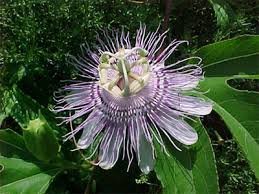
Passionflower
(Passiflora incarnata) is a perennial, climbing vine native to Southern and Central America and is cultivated in Europe. It reaches a height of 10-12 metres and climbs using thin tendrils to spiral around the host plant. The leaves are palmate, 3-lobed and alternate. The 5-petaled flowers have 5 sepals that make it look like the flower has 10 petals; they are pale blueish-white in color with a purple ‘fringe-like’ layer of fine petals on top. The flower has 5 pale colored stamens and 3 stigmas.
There are thought to be over 600 different forms of passiflora, commonly known as Passionflower, Maypops and also Maracuja in the Amazon. It was discovered in Peru in 1569 by the Spanish Doctor, Nicolás Monardes (c1493 – 1588). In 1608 Jesuit priests officially presented this herb from the New World to Pope Paul V by offering him dried samples of the plants and botanical illustrations. In the 17th century Giacomo Bosio a member of the Knights Hospitaller, referred to the passionflower as ‘La Flor de las cinco Llagas’, which translated as ‘the flower with 5 wounds’, a name that referenced the teachings of the Holy Catholic Church. The herb was used as a means to convert the Inca tribes to Christianity.
The passion flower tells the story of the Passion of Christ, it’s said that the 3 stamens represent the wounds of Christ, the sepals represent the apostles, and the corona (the frills around the stamens) are said to represent the crown of thorns.
The herb was discovered in the 16th century and it has taken over 100 years for the herbal wisdom of the passionflower to makes its way to the western world. In 1625 Tobia Aldinus, physician to Cardinal Farnese of Rome wrote in his book Hortus Farnesianus “This is the famous plant sung by poets and celebrated by orators. The plant reasoned about by philosophers, with the utmost subtlety, praised by physicians for its marvellous value. Sought for eagerly by the sick, wondered at by theologians, and venerated by all pious Christians”.
Some 8 years later, passionflower was added to the 1633 re-issue of John Gerard’s Herbal. Gerard died in 1612 and the publishers of the original version, Joyce and Bonham Norton, commissioned the botanist and apothecary Thomas Johnson (1600–1644) to revise and add to Gerard’s herbal. He did by all accounts most admirably, adding herbs from the new world to the book including the passionflower of which he wrote. Spanish Friers for some imaginary resemblances in the flower, first called it The Passion flower,” and made it as it were an Epitome of our Saviors passion.
The Passionflower is native to America and its medicinal uses were first discovered and used by the Native American’s. Passionflower is included in a Materia Medica written in Latin by the German botanist and physician Johann David Schoepf (1752-1800) and published in 1787. In one of the first reference books detailing the medicinal plants of the America’s, Schoepf mentioned the fact that the Native American’s used Passionflower to help in cases of epilepsy in the elderly. It became popular with the Victorians not as a medicine, but as an exotic bloom. In folklore the plant has been associated with calm and peace.
Passionflowers anti-spasmodic and sedative properties were documented, the authors wrote that “Its force is exerted chiefly upon the nervous system, the remedy finding a wide application in spasmodic disorders and as a rest-producing agent. It proves especially useful in the insomnia of infants and old people. It gives sleep to those who are laboring under the effects of mental worry or from mental overwork.”
Medicinal history: Used in the treatment of whooping cough, morphine habit, delirium tremens, convulsions in children and neuralgia, neuroses of children, teething and spasms, in the treatment of tetanus, hysteria, puerperal convulsions (involuntary spasms that occur in women just before, during, or just after childbirth), painful diarrhea, and acute mania.
Passionflower is widely used in sleep formulations, particularly when combined with valerian and/or hops.
Modern day herbalists utilize the aerial parts of the passion flower (flowers, leaves, and stems) for treating a variety of conditions, including insomnia and for pain relief, the variety commonly used medicinally is the Passiflora incarnate as it is the most medicinally beneficial variety. The herb is used to treat nervous tension, irritability, irritable bowel syndrome and premenstrual tension. An infusion of the plant is useful for treating back pain, due to its anti-spasmodic action. Passiflora contains a variety of alkaloids and flavonoids that are effective and non-addictive sedatives that do not cause drowsiness.
The herb contains a selection of indole alkaloids including harmine which as well as antidepressant properties, has insecticidal properties, and passiflorine, a substance which has been likened to morphine. Passionflower has a rich flavonoid content including luteolin an antioxidant studied for its potential immune system effects, and quercetin an effective bronchodilator, which can help reduce the release of histamine and other allergic or inflammatory chemicals in the body.
Cyanogenic glycosides are present along with the coumarins scopoletin and umbelliferone used as a sunscreen agent, and an optical brightener in the textile industry. Plant acids such as palmitic, oleic and myristic are present. Myristic acid is added to topical preparations for the skin as it aids absorbtion into the skin.
Passionflower leaves were used by tribes in the Amazon in poultices to heal cuts and bruises. The Cherokee used the herb in similar ways, and brewed the leaves and tendrils into a tea. The dried leaf and flowers can be combined with other herbs such as hops, chamomile and lavender to make a fragrant and soothing herbal sleep pillow. The dried leaf can be made into a bath tea with other soothing herbs such as lavender and rose petals to make a wonderfully fragrant and relaxing bath blend.
Passion Flower Tincture – Add Passion flower tincture to lotions, soaps, creams and bath products for the skin where astringency is required. No other non-medicinal uses are known for the tincture of this herb.
Do not take passionflower if you are pregnant or breastfeeding. Passion Flower should not be given to children under the age of 2.
It is used as a tea to counteract nervousness. It is a very useful herb for helping treat conditions such as neuralgia and insomnia. Passionflower has analgesic, anodyne, anti-depressant, anti-spasmodic, astringent, diaphoretic, hypnotic, narcotic, sedative and vasodilator properties. Passionflower is a wondrous relaxant and is particularly useful for those who are anxious. It has a quieting effect on the nervous system and in insomnia it produces normal sleep with no disturbance of the cerebral function. Passion Flower is a useful sedative and anti-spasmodic and is prescribed for convulsions, epilepsy, asthma, delirium tremens, and spasms of all kinds. It quiets the nervous system and leaves no harmful effects. It never stupefies the senses, and induces sleep except in cases when insomnia is due to pain”. Pictures below show the maypops and the fritillaria caterpiller who especially likes to eat the leaves. everywhere.
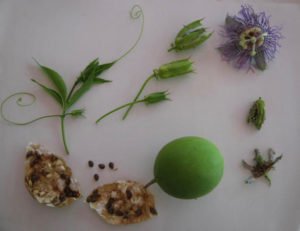
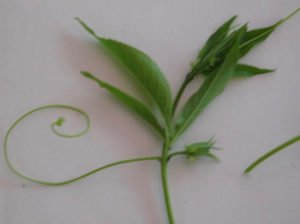


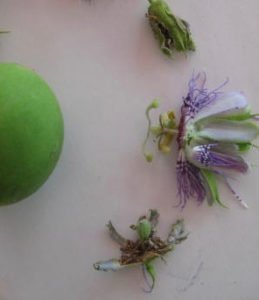


Fritillaria caterpillar and butterfly.
